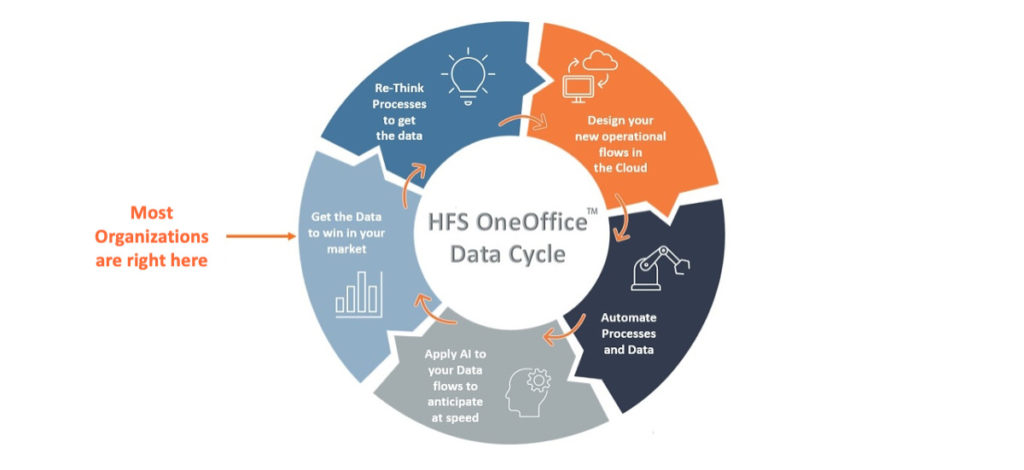Enterprise organizational structures have evolved from large teams located in one location to a geographically distributed workforce, from no ecosystem to a diverse ecosystem, and from hierarchical to flat structures. The evolution contributed to functional silos that served to inculcate organizational discipline but instead led to the dysfunction and delivery challenges that are conspicuous in healthcare. As the market demands faster, better, and cheaper, healthcare enterprises must rethink organizational structures as a significant driver to a better delivery paradigm.
The HFS OneOffice Organization is our view of what digital transformation looks like when put into action. It runs processes end-to-end across the organizational value chain. OneOffice brings together an enterprise’s most critical assets—health consumers, providers, and employees—to facilitate the employee experience to become a significant component of the overall experience, potentially a needle mover for the healthcare triple-aim (cost, health outcomes, and experiences). And, most importantly, it drives organizational alignment and metrics that measure the triple aim and not just cost reduction.
The OneOffice in Exhibit 1 represents a mindset shift to collaborative, cross-functional, enterprise operations powered by an integrated stack of emerging tech that complements your core, natively automates your processes, enables your people, and powers your decisions—breaking down your front-to-back legacy silos to create the only “office” that matters: OneOffice.

Source: HFS Research, 2021
At its core, the OneOffice is about making customer, employee, and partner experiences the heart of the strategy. In a OneOffice organization, automation becomes a native competency, where unleashing creativity and personal interaction augments human performance and where the immediacy of data creates insights to support decision-making that can make or break the firm. Consequently, digital is the only language operations must learn and understand to drive OneOffice success.
Health and healthcare measured as a function of the triple aim strongly indicate sub-optimum performance. Many reasons drive this sub-par performance, including demand-supply dynamics, burdensome regulations, consumer lifestyle choices, and organizational constructs. While each of these alone is a large hairy dragon worth slaying, it is the organizational construct that stands out as one within the control of healthcare enterprises to address.
The traditional value chains in Exhibit 2 have a linear construct and represent an analog way of doing business. These two-dimensional value chains group combinations of business processes, regulations, and contractual requirements and create silos by design. The silos have a propensity to drive constrained thinking associated with only the functions within the silo. The result of such insular behavior leads to un-coordinated and sub-optimal deliverables where operations may not be aware of new marketing campaigns, IT may not be prepared for a sales commitment, and finance may not have factored in the impacts of new regulations. The worst impact of this is on the consumer’s triple aim; they face heavy cost burdens, deteriorating health outcomes, and a diminished care experience because enterprise solutions do not effectively support their health.

Source: HFS Research, 2021
Digital is not actually about technologies; it is more about how we work. Digital is the license to reimagine how we work, conduct business, deliver for consumers, and more. It moves us away from two-dimensional thinking and doing toward the four-dimensional world we live in. Digital is an opportunity for healthcare to re-align itself to the outcomes they truly want to achieve (triple aim). The OneOffice mindset enables people with insights and automation prowess to elevate to a 21st-century business paradigm that can move the needle across the triple aim of health and healthcare.
Healthcare enterprises are sitting on a treasure trove of data, be it clinical, administrative, social determinants of health, or psychographics. However, data is the one asset that has been sub-optimized for various reasons, including data rights, regulations, and lagging investments in infrastructure to utilize data. Still, given access to an incredible data set, healthcare is likely ahead of the market (see Exhibit 3).

Source: HFS Research, 2021
Healthcare enterprises are notoriously siloed, translating into data residing in disparate systems, unconnected and uncontextualized. Consequently, the business does not convert data into insights that support it. On the contrary, data silos add to the business’ complexity such as when providers are incorrectly paid because health plans did not adjudicate claims properly using inaccurate benefits for instance. A part of healthcare operational complexity is a symptom of disparate systems and is pronounced because of the siloed organizational construct that makes cross-organizational communication difficult or delayed.
The increasing adoption of emerging technologies in healthcare, including smart analytics, artificial intelligence, and blockchain, gives enterprises tools to leverage data better. Technology is helpful, and businesses must leverage it, but a siloed organizational construct will limit success.
The notion of OneOffice is intuitive. We know through training and experience that OneOffice represents how organizations should structure to maximize their potential. Yet, from time to time, there is an organizational bias to constructing mini-universes for tactical reasons, short-term benefits, or situational politics. Any way we cut it, legacy organizational structures with silos are detrimental to success. The pandemic awakened us to the possibilities. We must drive those possibilities to their logical conclusion by building better, leveraging data assets we have, and reorienting to deliver as a whole—as OneOffice.
Register now for immediate access of HFS' research, data and forward looking trends.
Get StartedIf you don't have an account, Register here |
Register now for immediate access of HFS' research, data and forward looking trends.
Get Started